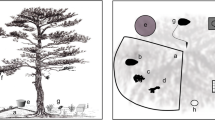Abstract
Seed hoarding behavior of the red squirrel,Sciurus vulgaris, was studied in relation to the amount of dispersed seeds of the Korean pine,Pinus koraiensis, and the distribution of its seedlings. After removing a cone from a tree, squirrels sat on the ground and ripped off its cone scales before transporting it. A mean of 3.2 seeds were scatter-hoarded per hole. Of 7.7×104 mature seeds produced in a 0.21 ha planted Korean pine forest, 22% were estimated to be directly eaten by four squirrels, 9% were hoarded by them in the pine forest and 65% were cached outside the forest. Squirrels rediscovered hoarded seeds frequently, until the ground was covered with snow, during the period from snow fall until seed germination the next spring, few hoarded seeds were utilized. Korean pine seedlings were found up to 600 m from their mother trees. Scatter-hoarding by squirrels extensively contributes to seed dispersal to places suitable for the regeneration of the Korean pine. The large size of the cone, the absciss-layer at the cone penduncle, the infrequent dehiscence of cone scales, the large and wingless seeds, and the thick seed-coats have probably all been specialized to facilitate utilization by GenusSciurus.
Similar content being viewed by others
References
Abbott, H. G. &Thomas, F. Q. (1970) Ecology of eastern white pine seed caches made by small forest mammals. Ecol.51:271–278.
Bromley, G. F. &Kostenko, V. A. (1967) Interrelationship between forest rodents and Korean pine in the forests of central and southern Sikhote-Alin. 64 pp. Institute of Biology and Soil Science. Far East Branch, Division of Siberia, the Academy of Sciences of the U.S.S.R., Vladivostok (In Russian).
Boyer, W. D. (1958) Long leaf pine seed dispersal in South Alabama. J. Forestry19:265–268.
Cahalane, V. H. (1942) Caching and recovery of food by the western fox squirrel. J. Wildl. Mgmt.6:338–352.
Coombs, F. (1978) The crows: A study of the corvids of Europe, 255 pp. B. T. Batsford Ltd., London.
Critchfield, W. B. & Little, E. L. Jr. (1966) Geographic distribution of pines of the world. 97 pp. U.S. Dept. Agr. For. Serv.
Hayashi, Y. (1969) The explanatory diagrams of the useful woody plants: Forest plants (Yuyo jumoku zusetsu: Rinboku hen). 472 pp. Seibundo-Shinkosha, Tokyo (In Japanese).
Imaizumi, Y. (1979) Seed storing behavior ofApodemus speciosus andApodemus argenteus. Zoological Magazine88:43–49.
Janzen, D. H. (1971) Seed predation by animals. Ann. Rev. Ecol. Syst.2:465–492.
Kato, J. (1985) Food and hoarding behavior of Japanese squirrels. Jap. J. Ecol.35:13–20.
Kawamichi, M. (1980) Food, food hoarding and seasonal changes of Siberian chipmunks. Jap. J. Ecol.30:211–220.
Krüssmann, G. (1972) Handbuch der Nadelgehölze. 366 pp. Paul parey, Berlin (In German).
Lanner, R. M. &Vander Wall, S. B. (1980) Dispersal of limber pine seed by Clark's nutcracker. J. Forestry53:637–639.
Ligon, J. D. (1978) Reproductive interdependence of pinõn jays and pinõn pines. Ecol. Monogr.48:111–126.
Mattes, H. (1982) Die Lebensgemeinschaft von Tanenhäher,Nucifraga caryocatactes (L.) und Arve,Pinus cembra L., und ihre forstliche Bedeutung in der oberen Gebirgswaltstufe. 74 pp. Swiss Federal Institute of Forestry Research, Birmensdorf (In German with English summary).
Miyaki, M. &Miyaki, Y. (1980)Sclurus vulgaris orientis, a planter of forests. Hoppo Ringyo32: 205–209 (In Japanese).
Nixon, C. M., Worley, D. M. &McClain, M. W. (1968) Food habits of squirrels in Southeast Ohio, J. Wildl. Mgmt.32:294–304.
Ognev, S. I. (1940) Mammals of the U.S.S.R. and adjacent countries. Vol. IV. Rodents, 429 pp. (Israel Program for Scientific Translations, Jersalem, 1966).
Saito, S. (1982) Morphological studies on the cones and seeds ofPinus pumila Regal collected at the Shiretoko Peninsula, easternmost Hokkaido. Bull. Shiretoko Museum4:19–28 (In Japanese with English summary).
Stebbins, G. L. (1971) Adaptive radiation of reproductive characteristic inAngiosperms. Ann. Rev. Ecol. Syst.2:237–260.
Thompson, D. C. &Thompson, P. S. (1980) Food habits and caching behavior of urban grey squirrels. Can J. Zool.58:701–710.
Vander Wall, S. B. &Balda, R. P. (1977) Coadaptations of the Clark's nutcracker and the pinõn pine for efficient seed harvest and dispersal. Ecol. Monogr.47:89–111.
Watanabe, Y. (1977) The red squirrel and the Korean pine: a role for plant dispersion. Nonezumi138:11–13. Hokkaido Shinrinboeki Kyokai, Sapporo (In Japanese).
Yano, M. &Ishikari Teichitai Research Group (1968) Outline of the plant remains from the Quaternary deposits in the Ishikari Plain, Hokkaido. The Quaternary Research7:41–50. Japan Association for Quaternary Research, Tokyo (In Japanese with English summary).
Author information
Authors and Affiliations
About this article
Cite this article
Miyaki, M. Seed dispersal of the Korean pine,Pinus koraiensis, by the red squirrel,Sciurus vulgaris . Ecol. Res. 2, 147–157 (1987). https://doi.org/10.1007/BF02346923
Accepted:
Issue Date:
DOI: https://doi.org/10.1007/BF02346923




